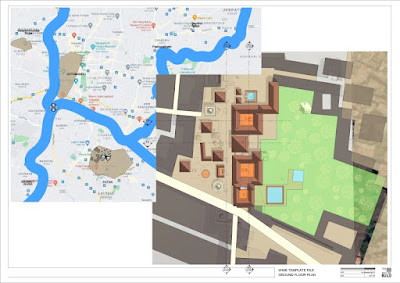Patan
Durbar in Kathmandu. That was an inspiring visit. One of my first trips after
moving to Dubai. It was such a novelty to be able to travel like that after
years in Zimbabwe where travel was an expensive luxury, although I did get a
few business trips, and one holiday in Mauritius before hyperinflation kicked
in.
This historic centre was walking distance from where my cousin lived at the
time so I was able to take quite a few digital photos and also picked up a book
with a number of hand drawn plans and Sections.
What I see in the plan view is an irregular clearing in the "forest" that is the dense street network. Running north to south, a group of palace buildings in a straight line dividing the public domain from a larger private royal garden. Dotted around the public square are Buddhist stupas and hindu pavilions. Between these, intensive activity, buying and selling, socialising, just passing through.
And of course the water spouts and ponds, rectangular, stepping down in
terraces. Ancient but still functioning. And everywhere the density of symbols,
carved in wood or stone, cast in bronze. Is there anything in our modern
culture to hold a candle to this exuberance?
I hope I am granted the time to take this study further, because I have barely
scratched the surface.
"The
Way We Build" was going to be a book title. That was my idea 25 years ago,
when l was still in Zimbabwe and before I started using Revit or blogging. I
had dabbled in the world of publishing, sporadically and had one foot planted
firmly in the digital realm.
Human beings have built for thousands of years, using different techniques and
materials, for different purposes, adapting to different climates and cultural
settings. As a former bricklayer, building teacher and now finally an architect
I thought I could weave stories about the human condition in words and pictures
that explored our rich history as builders.
Fast forward to 2012. Visiting my daughter in New Jersey and attending my first Revit conference in Atlanta. Experimenting with digital sketching tools. Fascinated by the evolution of different electrical systems, the reason for travel adapters, or just for confusion trying to use the bedside light.
Even my surname had morphed into a different spelling in the New World as it
branched off and developed its own norms, habits, solutions. Human groups have
been diversifying for hundreds of thousands of years, spreading out of Africa
and facing fresh challenges.
It puts our current hopes, fears and obsessions in perspective.
How
to get the spontaneity of hand sketching into the digital world and back again,
seamlessly? I have tried various solutions over the years. The inkling allowed
the natural feel of pen on paper to be captured and offered wonderful control.
But it was a one-way trip and a bit of a bumpy ride at that. These days I
mostly use my phone. Always on hand, always connected, seamless flow between
software packages. Cloud storage providing the link to other devices, bigger
screens, more oomph.
But the inkling tapped into the pen and paper experience much more faithfully.
Is it just me? Because I grew up that way? Any tool influences the way we work,
the texture of the end product. Do you want your building to be slick and
machine finished?
Or would you prefer the imperfections of hand-made. We have both in abundance
today. But do we know how to wield that power? How to balance emotion and
efficiency in our daily lives?
PS it's not repetition. Yesterday's image was a photograph of the ink-on-paper
drawing created while the device records the movements. Today's is the digital
file transferred from the little clip on box to my laptop.





No comments:
Post a Comment
I've been getting a lot of spam so had to tighten up comments permissions. Sorry for any inconvenience. I do like to hear from real people